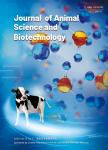Characterization of blood flow and the effects of exogenous estradiol benzoate on residual follicles formed after ultrasound-guided transvaginal follicle aspiration in cattle
Characterization of blood flow and the effects of exogenous estradiol benzoate on residual follicles formed after ultrasound-guided transvaginal follicle aspiration in cattle作者机构:Universidade Federal Fluminense Niteroi RJ 24230-340 Brazil Embrapa Gado de Leite Juiz de Fora MG 36038-330 Brazil Universidade Jose do Rosario Vellano Alfenas MG 37130-000 Brazil Embrapa Recursos Geneticos e Biotecnologia PqEB Av. W5 N Brasilia DF 70770-917 Brazil
出 版 物:《Journal of Animal Science and Biotechnology》 (畜牧与生物技术杂志(英文版))
年 卷 期:2017年第8卷第1期
页 面:51-56页
核心收录:
学科分类:0710[理学-生物学] 0831[工学-生物医学工程(可授工学、理学、医学学位)] 0832[工学-食品科学与工程(可授工学、农学学位)] 1004[医学-公共卫生与预防医学(可授医学、理学学位)] 0905[农学-畜牧学] 0906[农学-兽医学] 09[农学] 0703[理学-化学] 0836[工学-生物工程]
基 金:supported by the Minas Gerais State Research Foundation (FAPEMIG, Project APQ CVZ 02863/09) from Embrapa (Project 01.07.01.002.05)
主 题:Doppler Ovary Ovum pick up Steroidogenesis Vascularization
摘 要:Background: Removal of the follicular content by ultrasound-guided transvaginal follicle aspiration(TVFA) may fail to induce immediate atresia and loss of function, resulting in the occurrence of residual follicles(RF). The aims of this study were to characterize the blood flow in RF and to determine the effects of the treatment with estradiol benzoate on RF fate. Lactating, cyclic Holstein-Gir crossbred cows were used. In Experiment 1, follicular wave emergence(D0) was synchronized in cows(n = 10) and follicular growth was then monitored by transrectal ultrasonography from D0 to D8, followed by TVFA of the largest follicle present on the ovaries 24 h later. Color Doppler ultrasound imaging was used to examine blood flow on the follicular wall, which was recorded immediately before and every 12 h after TVFA, up to 72 h. In experiment 2, cows(n = 22) were randomly allocated to receive either 2 mL of saline i.m.(Control group, n = 11) or 2 mL estradiol benzoate i.m.(EB group, n = 11)immediately after TVFA. Ovaries were scanned every 12 h to confirm the presence and to measure the diameter of RF. The contents of the RF, if present, were collected 72 h after the first TVFA, using the same aspiration *** fluid from original follicles and RF were stored at-20 °C until hormonal ***: In Experiment 1, there was no reduction(P 〉 0.05) of blood flow in the remaining follicle walls after TVFA and maximum blood flow values were observed at 49.5 ± 19.7 h post-TVFA. In Experiment 2, formation of RF after TVFA was proportionally similar between Controls(5/9) and EB(5/10) cows. Also, RF diameter did not differ between groups(P 〉 0.05). Nonetheless, the content of RF from cows in the EB group had lower(P = 0.0004)estradiol(E2) concentration and lower(P = 0.0005) E2:P4 ratio compared with ***: In conclusion, 1) the persistence of vascularization in the remaining follicle wall may contribute to the formation of RF after follicle aspiration,



